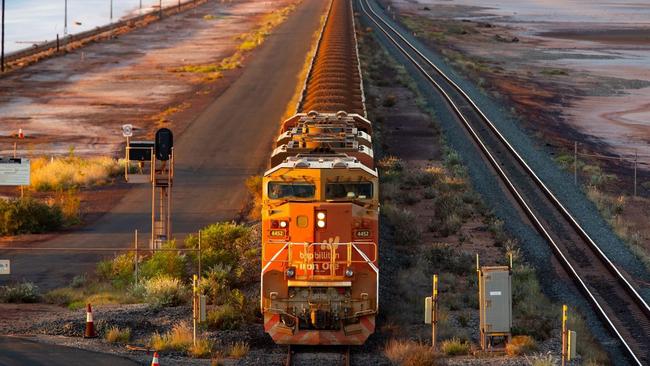Weaker mining sector forecasts drag market down
The Australian sharemarket finished the week in the red, weighed down by weaker mining sector forecasts and higher global interest rate fears.

Downward pressure on mining sector forecasts emerged as a potential drag on the sharemarket at the end of a tough week dominated by fear of higher interest rates globally.
Goldman Sachs cut its rating on BHP to neutral and lowered its 2022-23 earnings forecasts for some of the world’s biggest miners by an average of 20 per cent, based on downward revisions to its commodity prices, which have fallen about 25 per cent from their April highs.
At the same time, Morgan Stanley slashed its 12-month price targets for Evolution Mining, Northern Star and OZ Minerals by an average of 30 per cent as it warned of potential impacts of employment shortages and inflation on production, costs and project capex.
And Rio Tinto kicked off June quarter production updates by missing consensus estimates.
The local sharemarket has outperformed most global markets this year, falling just over 11 per cent while the S&P 500 is down 20 per cent, mainly because of an additional boom in commodity prices caused by Western sanctions on Russia since the Ukraine war.
The local bourse has arguably been helped by a 7 per cent fall in the dollar this year as the Reserve Bank abruptly embraced aggressive interest rate rises amid similar moves offshore.
Overall, the risk aversion in global markets this week could have been worse. The S&P/ASX 200 index fell 1.2 per cent to 6605.6 points, the S&P 500 index was heading for a 2.8 per cent fall, while the dollar fell 1.9 per cent to US67.25c.
Commodities fell, with spot iron ore down 6.8 per cent at $US106.01 a tonne, West Texas crude oil down 8.1 per cent at $US96.27 a barrel and Comex copper down 10 per cent at $US3.18 a pound.

Long-term bond yields fell on recession risks, with the US 10-year down 13 basis points at 2.95 per cent.
But the risk aversion and safe-haven demand was relatively tame considering US headline CPI blew out to a four-decade high of 9.1 per cent, versus 8.8 per cent expected by economists. Core US CPI also exceeded estimates and inflationary pressures broadened.
JPMorgan and Morgan Stanley missed earnings estimates, and the former suspended share buybacks.
Fed officials Christopher Waller and James Bullard helpfully pushed back on speculation of a 100-basis-point rate rise in July after Atlanta Fed president Raphael Bostic had said “everything is in play”.
Still, the shape of the US yield curve – while distorted by quantitative easing in recent years – increasingly warns of a looming US recession. And it may be hard for the Fed to change course until inflation shows clear signs of a peak. US inflation has surprised on the upside for well over a year.
Meanwhile in Australia, an unexpected plunge in the nation’s unemployment rate to a 48-year low of 3.5 per cent highlighted the chronic labour shortages – exacerbated by a high number of people working fewer hours than usual due to Covid-19 and influenza – now faced by corporate Australia.
The jobs data also fuelled expectations of more aggressive and sustained interest rate rises by the RBA, with several economists now expecting a 75-basis-point move next month.
Goldman Sachs noted that, while the average level of commodity prices in the June quarter was flat compared to the average in the March quarter, a 25 per cent fall from April peaks has been driven by macro concerns as investors have questioned the extent of a second-half economic recovery in China and the likelihood of a global recession.
“While we believe that the long-term fundamentals are unchanged for commodities, with supply remaining tight and inventory draws continuing, we acknowledge the heightened risks in the coming quarters and expect the focus on this results season to be on forward-looking guidance,” Goldman Sachs analyst Geydar Mamedov said.

“We also noted the inflationary pressures faced by the mining sector – having modelled a 20 per cent rise in net cash cost inflation this year – and remained cautious on the production outlook after March quarter disappointments, misses and continued challenges in key regions. Thus, we expect a number of downward guidance revisions this results season.
“Despite this, we still see strong earnings this year, which we expect to translate into record shareholder returns as companies’ preference for growth capex remains low.”
While remaining constructive on a China recovery and structurally tight sustaining development capex, Mamedov warned of “downside earnings risk to our coverage given recession concerns”. He noted that sell-offs in Goldman Sachs’ commodity basket in previous downcycles averaged about 20 per cent – excluding the global financial crisis of 2008, when it fell 20 per cent.
With that in mind, Mamedov and his team slashed their target price-to-earnings multiples for their mining sector coverage by 10 per cent on average, which “reflects the extent to which the multiple derated in prior rate hike cycles for our sector”.
Lower target valuation multiples plus downward revisions to earnings estimates caused an average 30 per cent downgrade to the broker’s 12-month price targets for the nine miners in its coverage.
Similarly, Morgan Stanley’s Rahul Anand said Covid impacts, labour shortages and inflation could affect production, costs and capex for miners in his coverage.
Yet increased production quarter on quarter would be needed for BHP, IGO, Northern Star, Mineral Resources, South32 and Whitehaven Coal if they were to meet their full-year production guidance.
So far Evolution, OZ Minerals and Allkem have downgraded a mix of production and cost guidance for fiscal 2022 or calendar 2022, citing labour shortages and cost inflation in diesel and power.
Regis Resources has flagged expectations of costs at the upper end of fiscal 2022 guidance.
“We expect this could be a running theme, and see this as a risk to achieving fiscal 2022 guidance and also the outlook for fiscal 2023 guidance,” Anand said.



